英 语 短 语 大 全 及 常 用 词 组
常用英语动词短语 固定搭配
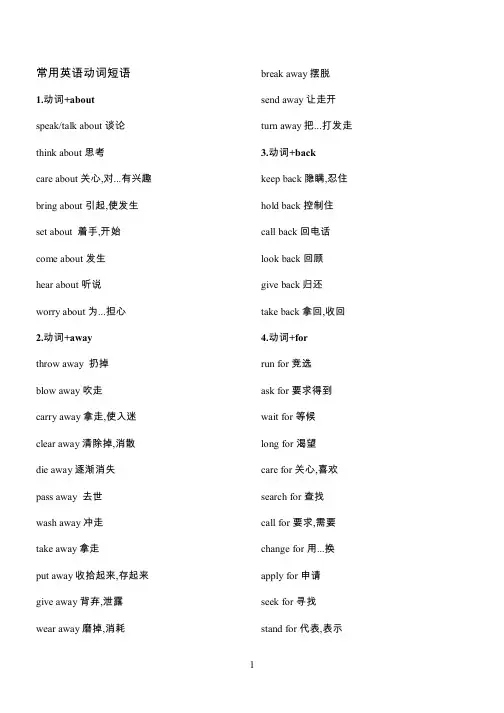
价要,费收 rof egrahc 找寻 rof tnuh
是...为以误 rof ekat
取来,拿来 rof emoc
找寻 rof kool 求乞 rof geb
击袭...向 ta emoc
到得望希 rof hsiw/epoh
3 演上,上戴,上穿 no tup 耀炫 ffo wohs
续继 no og/peek 持坚 no tsisni
盖复……被 htiw derevoc eb)5
8 问访 ot ti siv a yap
样榜立树...为 ot elpmaxe na tes
出外/家在/来回 tuo/ni/kcab eb)1 组词的成构 eb 由)一(●
班上/家在 krow/emoh ta eb)2
始开真认 ot nwod teg 住握 fo dloh ekat
交上 ni dnah
替接,管接 revo ekat 服克 revo teg
究研,查检,阅审 revo og
入进,获收 ni teg
写填 ni llif
想细,倒翻 revo nrut revo+词动.41
成译...把 otni etalsnart/tup 成分...把 otni edivid
入收到得使,进引 ni gnirb
成组...由 f o tsisnoc 到想 fo kniht fo+词动.8
成赞 fo evorppa
近走勿,开避 ffo peek 绝断,断切 ffo tuc
落撞...把 ffo kconk
清还 ffo yap
开离分...把 m orf etarapes
迟推,期延 ffo tup
候时...于始 morf etad 习学...向 m orf nrael
(完整版)英语语法术语
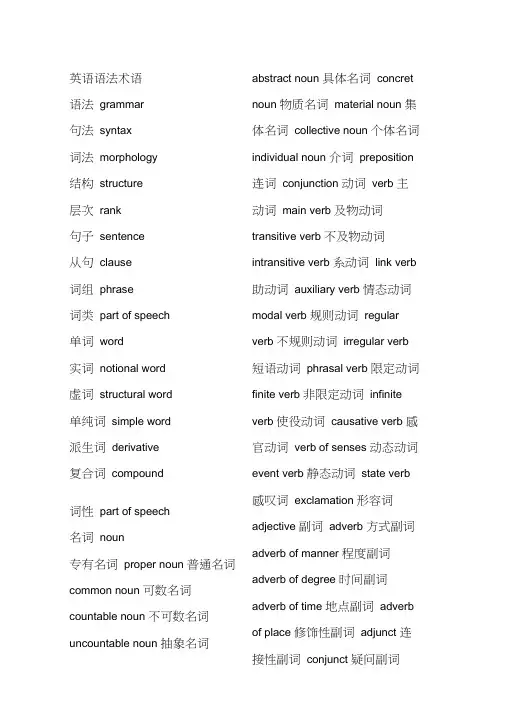
英语语法术语语法grammar句法syntax词法morphology结构structure层次rank句子sentence从句clause词组phrase词类part of speech单词word实词notional word虚词structural word单纯词simple word派生词derivative复合词compound词性part of speech名词noun专有名词proper noun 普通名词common noun 可数名词countable noun 不可数名词uncountable noun 抽象名词abstract noun 具体名词concret noun 物质名词material noun 集体名词collective noun 个体名词individual noun 介词preposition 连词conjunction 动词verb 主动词main verb 及物动词transitive verb 不及物动词intransitive verb 系动词link verb 助动词auxiliary verb 情态动词modal verb 规则动词regular verb 不规则动词irregular verb 短语动词phrasal verb 限定动词finite verb 非限定动词infinite verb 使役动词causative verb 感官动词verb of senses 动态动词event verb 静态动词state verb 感叹词exclamation 形容词adjective 副词adverb 方式副词adverb of manner 程度副词adverb of degree 时间副词adverb of time 地点副词adverb of place 修饰性副词adjunct 连接性副词conjunct 疑问副词interrogative adverb 关系副词relative adverb代词pronoun 人称代词personal pronoun 物主代词possessive pronoun 反身代词reflexive pronoun 相互代词reciprocal pronoun 指示代词demonstrative pronoun 疑问代词interrogative pronoun 关系代词relative pronoun 不定代词indefinite pronoun 物主代词possessive pronoun 名词性物主代词nominalpossessive pronoun 形容词性物主代词adjectival possessive pronoun冠词article定冠词definite article 不定冠词indefinite article数词numeral基数词cardinal numeral 序数词ordinal numeral 分数词fractional numeral形式form单数形式singular form 复数形式plural form 限定动词finite verb form 非限定动词non-finite verb form 原形base form从句clause从属句subordinate clause 并列句coordinate clause 名词从句nominal clause 定语从句attributive clause状语从句adverbial clause 非真实条件状语从句adverbial宾语从句object clause主语从句subject clause 同位语从句appositive clause时间状语从句adverbial clause of time地点状语从句adverbial clause ofplace方式状语从句adverbial clause ofmanner让步状语从句adverbial clause ofconcession原因状语从句adverbial clause ofcause结果状语从句adverbial clause ofresult目的状语从句adverbial clause ofpurpose条件状语从句adverbial clause of condition真实条件状语从句adverbial clause of real conditionclause of unreal condition 含蓄条件句adverbial clause of implied condition 错综条件句adverbial clause of mixed condition 句子sentence简单句simple sentence 并列句compound sentence 复合句complex sentence 并列复合句compound complex sentence陈述句declarative sentence 疑问句interrogative sentence 一般疑问句general question 特殊疑问句special question 选择疑问句alternative question 附加疑问句tag question 反义疑问句disjunctive question 修辞疑问句rhetorical question 感叹疑问句exclamatory question存在句existential sentence 肯定句positive sentence基本句型basic sentence pattern 否定句negative sentence 祈使句imperative sentence 省略句elliptical sentence 感叹句exclamatory sentence句子成分members of sentences 主语subject谓语predicate 宾语object 双宾语dual object 直接宾语direct object 间接宾语indirect object 复合宾语complex object 同源宾语cognate object 补语complement 主补subject complement 宾补object complement表语predicative定语attribute 同位语appositive 状语adverbial句法关系syntactic relationship 并列coordinate 从属subordination 修饰modification前置修饰pre-modification 后置修饰post-modification 限制restriction双重限制double-restriction 非限制non-restriction数number单数形式singular form 复数形式plural form 规则形式regular form 不规则形式irregular form格case普通格common case 所有格possessive case 主格nominative case宾格objective case性gender阳性masculine阴性feminine通性common中性neuter人称person第一人称first person第二人称second person 第三人称third person时态tense过去将来时past future tense 过去将来进行时past future continuous tense 过去将来完成时past future perfect tense一般现在时present simple tense 一般过去时past simple tense 一般将来时future simple tense 现在完成时past perfect tense 过去完成时present perfect tense 将来完成时future perfect tense 现在进行时present continuous tense过去进行时past continuous tense将来进行时future continuous tense过去将来进行时past future continuous tense 现在完成进行时present perfect continuous tense过去完成进行时past perfect continuous tense 语态voice 主动语态active voice 被动语态passive voice语气mood陈述语气indicative mood 祈使语气imperative mood 虚拟语气subjunctive mood否定negation否定范围scope of negation 全部否定full negation 局部否定partial negation 转移否定shift of negation语序order自然语序natural order倒装语序inversion全部倒装full inversion 部分倒装partial inversion直接引语direct speech 间接引语indirect speech 自由直接引语free direct speech 自由间接引语free indirect speech一致agreement主谓一致subject-predicate agreement语法一致grammatical概念一致notional agreement 就近原则principle of proximity强调emphasis重复repetition 语音pronunciation 语调tone 升调rising tone 降调falling tone 降升调falling-rising tone文体style 正式文体formal 非正式文体informal 口语spoken/oral English 套语formulistic expression 英国英语British English 美国英语American English 用法usageTerms of English Language Teaching Methodologyagreement感情色彩emotional coloring 褒义commendatory 贬义derogatory 幽默humorous讽刺sarcastic挖苦ironicachievement test acquisition acquisition active mastery active vocabulary affective filtering aim,objective analysis of errors analytic approach analytical reading 英语教学法术语成绩测试习得,语言习得语言习得顺序积极掌握积极词汇,主动词汇情感筛选目的,目标错误分析分析教学法,分析法分析性阅读application to practice 运用于实践approach 教学路子aptitude test 能力倾向测验Army method 陆军法associative learning 联想性学习auditory discrimination 辨音能力auditory feedback 听觉反馈auditory memory 听觉记忆auditory perception 听觉audio-lingual method 听说法audio-visual method 视听法aural-oral approach法听说教学法,听说aural-oral method 听说法Bbasic knowledge基本知识basic principle 基本原则basic theory 基本理论basic training 基本训练basic vocabulary 基本词汇behaviourism 行为主义bilingual 双语的bilingual education 双语教育chain drill 链式操练,连锁操练choral repetition 齐声照读,齐声仿读class management 课常管理classroom interaction 课常应对cloze 完形填空coach 辅导cognitive approach 认知法common core 语言的共同核心,语言共核communicative drill 交际性操练communicative exercise 交际练习communicative langunge teaching 派语言教学法,交际教学法交际community language learning学习法集体语言comparative method 比较法communicative approach 交际法comprehensible input 不难理解的输入comprehensive method 综合法computer-managed instruction管理教学计算机concord and coordination 默契与配合console 控制台consonant cluster 辅音连缀applied linguistics 应用语言学blank filling 填空context 上下文controlled composition 控制性作文direct learning 直接学习cue word 提示词curriculum 课程,教学大纲curriculum development课程设计课程编制,cultrual objective,aim 教养目的cclical approach 循环教学法,循环法Ddeductive learning演绎性学习deductive method 演绎法delayed auditory feedback馈延缓听觉反demonstration 演示educational objective, aim 教育目的EFL 英语作为外语EGP通用英语ELT 英语教学English as a Foreign Language 为外语英语作English as an InternationalLanguage 英语作为国际语言English environment 英语环境English for Academic Purposes语学术英English for general prupose 普通英语English for General Purposes 语通用英demonstration lesson 示范教学describe a picture in writing 看图说话describe a picture orally 描写语言学diagram 图解diagnostic test 诊断性测验dicto-comp 听写作文direct application 直接应用English for specific purposes 专用英语ESOL English for Speakers of Other Languages 供非英语民族使用的英语English medium school 英语授课学校English teaching;teaching English 英语教学WSD( English as a Second Dialect ) 英语作为第二方言WSL( English as a Second Language) 英语作为第二语言course density 课堂密度course design 课程设计cramming method 灌输式direct method 直接教学法direct comprehension 直接理解ESL Programme( English as a Second Language Programme)英语(第二语言)教程ESP( English for Special Purposes ) 专用英语EST( English for Science andTechnology ) 科技英语evaluation 评语,评价examination 考试examination question 考题experimental method 实验法extensive reading 泛读external speech 外语言语extra-curiculum activity 课外活动extra-curriculum club,group 课外小组F al approach 功能法al syllabus 功能派教学大纲word 功能词Ggeneral linguistics 普通语言学gestalt style 格式塔式(学习),整体式(学习)gesture 手势getting students ready for class 织教学组global learning 式学习整体式学习,囫囵吞枣global question 综合性问题gradation 级进法,分级递升法graded direct method 循序直接法grading 级进法,分级递升法;评分facial expression feedbace 反馈film projector filmstrip finalstage first language formative evaluation free practice面部表情电影放映机高级阶段第一语言,母语自由作文自由练习电影胶片grammar lessongrammar methodgrammar translation method法grammatical analysisgroup readinggroup trainingguided composition语法课语法法语法翻译语法分析集体朗读集体练习引导性作文frequency of word 词的频率H integrated approach法综合教学法,综合heuristic method of teaching 教学法启发式intelligent memory 理解性记忆heurstics 启发法;探索法language training强化教学humanistic approach 人本主义教学法intensive training 精读intermediate stage 中级阶段Iinterpretation头口翻译idealism 唯心主义International Phonetic Alphabet 国际imitatiom 模仿音标immersion programme 沉浸式教学Jimparting knowledge 传授知识juncture连读,音渡incomplete plosive 不完全爆破junior high school初级中学independent composition 独立作文junior school初级学校individualized instruction 个别教学junior sceondary school初级中等学校individual training 个别练习junior-senior high school初高中inductive learning 归纳性学习junior technical college(orinductive method 归纳法school) 初级职业学院(或学校)inflection,inflexion 词形变化junior year 大学三年级information,processing 信息处理Kinitial beginning stage 初级阶段key words基本词,关键字inner speech 内语言语kinesics 身势语,身势学in-service training 在职培训kinesthetic memory 动觉记忆instructional objective 语言教学目标knowledge知识integrative teaching 综合教学knowledge structure 知识结构Llanguage acquisition 语言习得language acquisition device 语言习得机制language arts 语言技能language competence,or knowledge 语言知识language learning capability 语言学习能力language laboratory;lab 语言实验室language leaning capacity 语言学习能力language pedagogy 语言教育language performance 语言行为language program design 语言课程设计language test 语言测试learning by deduction 演绎性学习learning by induction 归纳性学习learning process 学习过程learning style 学习方式lesson conducting 教课lesson plan 课时计划,教案lesson preparation 备课lesson type 课型linguistics 语言学linguistic method 口语领先教学法living language 活的语言long-term memory 长期记忆look-and-say method 看图说话法meaningful drill 有意义的操练neabubgful exercise 有意义的练习meaningful learning 理解性学习means of teaching 教学手段mechanical drill 机械操练mechanical exercise 机械练习mechanical memory 机械记忆mechanical translation 机器翻译medium of instruction 学语言教学媒介语,教memory 记忆,记忆力memory span 记忆幅度memorizing 用记记住method 方法methodology of teaching 教学法methodology of teaching English 教学法英语microteaching 微型教学mim-mem method 模仿—记忆法linguistic competence 语言能力minimal pair 习)最小对立体(一种辨音练optimum age hypothesis说学习最佳年龄model 模型operating principle 操作原则modeling 示范教学oral approach 口语教学法,口语法modern equipment 现代化设备oral exercise 口语练习modern language 现代语言oral method 口授法monitor hypothesis 语言监控说oral reading 朗读mother tongue 母语order of acquisition 语言习得顺序motivation 引起动机organization of teaching materials 教材组织Norgans of speech 发音器官native language 本族语outside reading课外阅读natural appoach 自然教学法,自然法overlearing过量学习natural method 自然法Pneeds analysis 需要分析paired-associate learning 配对联想学new lesson 新课习法nine-pile grading 九堆法pair work 双人作业,双人练习notional approach 意念法passive vocabulary消极词汇notional-al syllabus 意念- 功能派教学pattern drill 句型操练大纲pattern practice 句型练习notional syllabus 意念大纲、意念派教学大纲pdeagogical grammar 教学语法Opedagogy 教育法peer teaching 同学互教observation lesson观摩教学penmanship handwriting 书法objective 教学目标知觉perceptionperformance objective 语言实践目标proficiency 熟练personality 个性program desing 课程设计philosophy 哲学psycho-linguistics 心理语言学phoneme 音素psychological method 心理法phonetics 语音法Qphonetic method 按字母音值拼读法qualified teacher 合格教师phonology 音位学question band 试题库picture 图画questionnaire 调查问卷phasement test 分班测验questions 提问plateau of learning 学习高原Rpractical objective 实用目的practice effect练习效应rapid reading 快速阅读,快读practice of teaching教学实践rate of reading 阅读速度presentation of new materials 提出新readability 易读性材料read by turns轮读pre-teaching 预教reading 阅读primary of speech 口语领先reading lesson 阅读课principle of communication 则交际性原reading method 阅读法principle ofteaching 教学原则reading speed 阅读速度problem solving 习题解答reading vocabulary汇量阅读词汇,阅读词production stage 活用阶段,产出阶段receptive language knowledge 接受性productive exercise 活用练习语言知识receptive vocabulary 领会词汇productive mastery 活用掌握productive vocabulary 活用词汇reformed method 改良法regression 回看,重读reinforcement 巩固reinforcement lesson 巩固课repetition drill 复述操练repetition-stage 仿照阶段response 反应retelling 复述retention 记忆teview;tevision 复习review ( revise ) 查and check up复习检review ( revision )lesson 复习课rewriting 改写rhythm 节奏role-play 扮演角色rote learning 强记学习法,死记硬背Sscanning 查阅,扫瞄school practice 教学实习scientific way of thinking 想方法科学的思second language 第二语言segment 音段,切分成分semantics 语义学seminar 课堂讨论sentence completion 完成句子short-term memory 短期记忆sight vocabulary 一见即懂的词汇silent reading 默读silent way 沉默法,静授法simplification 简写simplified reader 简写读本simulation 模拟,模拟性课堂活动simultaneous interpretation 同声翻译situational method 情景法situational language teaching 情景派语言教学法,情景教学法situational method 情景教学法situational syllabus 情景派教学大纲situation reinforcement 情景强化法skimming 略读,济览slide 幻灯片slide projector 幻灯片socialized speech 社会化言语socio-linguistics 社会语言学soft ware 软件speech disorder 言语缺陷speech pathology 言语病理学speech perception 言语知觉speech reading 唇读法speed reading 快速阅读,快读speelling 正字法spiral approach 螺旋式教学法,螺旋法spoken lauguang 口语stage of teaching 教学阶段stick drawing;mathch drawing 简笔画stimulus and response 刺激与反应stress accent 重音,重读structuralism 结构主义(语言学)structural method 结构法student-centered 学生中心student-centered learning习法学生为主学student teacher 实习教师student teaching 教育实习submersion programme 沉浸式教程substitution 替换substitution table 替换表subvocal reading 默读suggestopaedia 暗示教学法syllabus 教学大纲syllabus design 教学大纲设计syllabus for middle school English 中学英语教学大纲synthetic approach 综合性教学法,综合法synthetical reading 综合性阅读Ttarget language目的语,译文语言teacher ' s book 教师用书teacher ' s manual 教师手册teaching experience 教学经验teaching objective,aim 教学目的teaching procedure 教学过程teaching tools;property 教具teaching words in isolation词孤立教单theory of teaching 教学理论TEFL 英语(外语)教学TESL 英语(第二语言)教学TESOL 对非英语民族教英语time allotment 时间分配total physical response method 整体动作反应法transformation drill 转换操练translation method 翻译法transformational generativegrammar 转化生成语法Uunconscious潜意识underclassman 低年级学生undergraduate course 大学本科课程undergraduate school 大学本科学院undergraduate special 大学特殊课程unified studied 统一课程university high school 大学附属中学university of the air 广播电视大学word association 词际联想word list 词表word study 词的研究word frequency 词汇重复率written language 书面语updating courses/training 现代化课程/ 训练upgrading courses/training 进修课程/ 训练upperclassman 高年级学生use and usage 使用和用法utterance 语段Vverbal association词语联想verbal learning 语言学习,单词学习video 电视,影象videotape 录象磁带visual perception 视觉visual aid 直观手段visit a class 听课visual memory 视觉记忆vocabulary control 词汇控制感情色彩emotional coloring褒义commendatory贬义derogatory幽默humorous讽刺sarcastic挖苦ironic英语教学术语Approach 教学路子undergraduate 大学本科生Communicative approach 交际法论Communicative language teaching交际语言教学Method 教学方法Syllabus design教学大纲设计Frist language母语Second language第二语言Foreign language外语Target language目的语言Techniques技巧Brainstorm 指就某一问题随便发表观点或建议的过程Group-work 小组活动Pair-work 两人一组的活动View of work 语言理论或对语言的认识Structural view 结构主义语言理论Functional view 功能主义语言理Interactional view 交互语言理论Behaviourist theory 行为主义学习理论Cognitive theory 认知学习理论Process-oriented theory 强调过程的语言学习理论Condition-oriented theory 强调条件的语言学习理论Audiolingual theory 外语教学听说法TPR:total physical respone 全身反应法Silent way 沉默法Natural approach 自然法Reflective teaching反思教学Communicative approach 交际法或交际路子Communicative competence 交际能力Linguistic competence语言能力Teaching procedures教学步骤Teaching aids 教学辅助材料和设备Variety 多样性Flexibility 灵活性Learnability 可学性Linkage连接Micro planning 微观备课Macro planning 宏观备课RP:received pronunciation 英国伦敦附近的一种方言。
人教版高中英语全册重点词汇短语句子(概括)
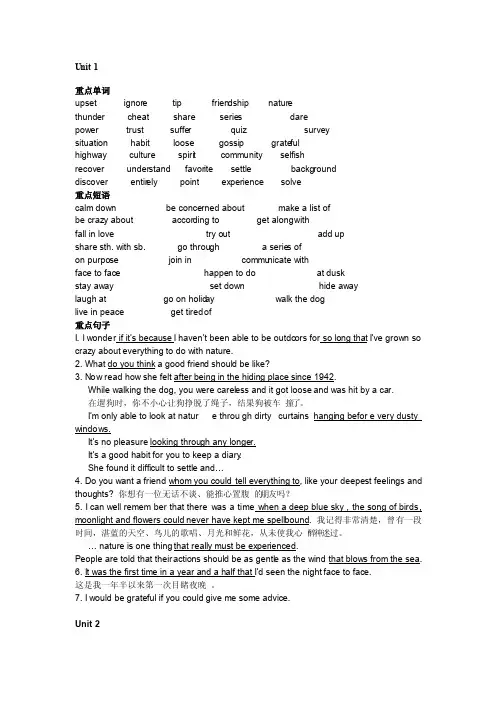
重点单词upset ignore tip friend ship naturethunde r cheat share series darepower trust suffer quiz surveysituat ion habit loose gossip gratef ulhighwa y cultur e spirit commun ity selfis hrecove r unders tand favori te settle backgr ounddiscov er entire ly point experi ence solve重点短语calm down be concer ned aboutmake a list ofbe crazyabout accord ing to get alongwithfall in love try out add upsharesth. with sb. go throug h a series ofon purpos e join in commun icate withface to face happen to do at duskstay away set down hide awaylaughat go on holida y walk the doglive in peace get tiredof重点句子I. I wonder ifit’sbecaus e I haven’tbeenabletobeoutdoo rs for so long that I’vegrownso crazyabouteveryt hingto do with nature.2. What do you thinka good friend should be like?3. Now read how she felt afterbeingin the hiding placesince1942.Whilewalkin g the dog, you were carele ss and it got looseand was hit by a car.在遛狗时,你不小心让狗挣脱了绳子,结果狗被车撞了。
大学英语语法全集

从句
a)主语从句(subject clause)如What I want to say is this(我要说的是这么一点)中的what I want to say。
b)表语从句(predicative clause)如This is what I want to say(这是我要说的)中的what I want to say。
c)宾语从句(object clause)如I have said what I want to say(我说完了我要说的话)中的what I want to say。
d)定语从句(attributive clause)如This is the thing I want to say(这就是我要说的)中的I want to say。
名词的种类
普通名词的种类
1)类名词(class noun)类名词表示人或事物属 于某一类。如:
tractor 拖拉机 panda 熊猫 factory 工厂 teacher 教员 2)集体名词(collective noun)集体名词是一些
人或物的总称。如: class 阶级,班 herd 兽群 crowd 人群 army 军队
句子
从说话人说话的目的来看,句子可分为: a)陈述句(declarative sentence)用来表达一件事,
如: I saw him yesterday.昨天我看见他了。 b)疑问句(interrogative sentence)用来提出疑问, 如: Did you see him yesterday?你昨天见到他了 吗? c)祈使句(imperative sentence)表示恳求、命令 等,如: Please come in.请进来。
3)表语(predicative)它是放在连系动词之后表 示主语的身分或特征的,如I am a student(我 是一个学生)中的student;Our classroom is clean(我们的教室很干净)中的clean。
高中英语常用单词词组的用法和例句
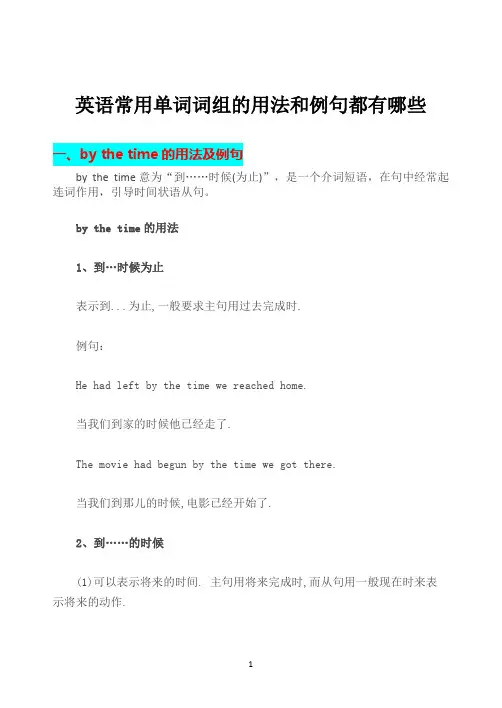
英语常用单词词组的用法和例句都有哪些一、by the time的用法及例句by the time意为“到……时候(为止)”,是一个介词短语,在句中经常起连词作用,引导时间状语从句。
by the time的用法1、到…时候为止表示到...为止,一般要求主句用过去完成时.例句:He had left by the time we reached home.当我们到家的时候他已经走了.The movie had begun by the time we got there.当我们到那儿的时候,电影已经开始了.2、到……的时候(1)可以表示将来的时间. 主句用将来完成时,而从句用一般现在时来表示将来的动作.I will have finished the work by the time my father comes back.(2)可以表示过去的时间. 主句用过去完成时,而从句用一般过去时.He had built a lab for himself by the time he was 12 years old.注:如果只是说过去某个时候的状况,用过去时,而不用完成时。
例句: By the time the war was over , death and suffering were to be seen everywhere.在战争结束的时候,到处可见死亡和饥饿。
这里没有“死亡和饥饿”已经完成的意思,只是描述当时这个时间点的状况。
所以用过去时。
二、beneficial的用法搭配及例句beneficial:形容词,意为有益的;有利的;有帮助的,侧重对健康、身心或事业有益。
beneficial后面通常加for 或to,构成搭配be beneficial for和be beneficial to。
1 beneficial的用法英[benɪ'fɪʃ(ə)l] 美[,bɛnɪ'fɪʃl]adj. 有益的,有利的;可享利益的例句:1、I have mentioned a number of times the beneficial effects of music playedto the unborn child.我已数次谈及给未出生孩子播放音乐的益处。
英语语法简要归纳
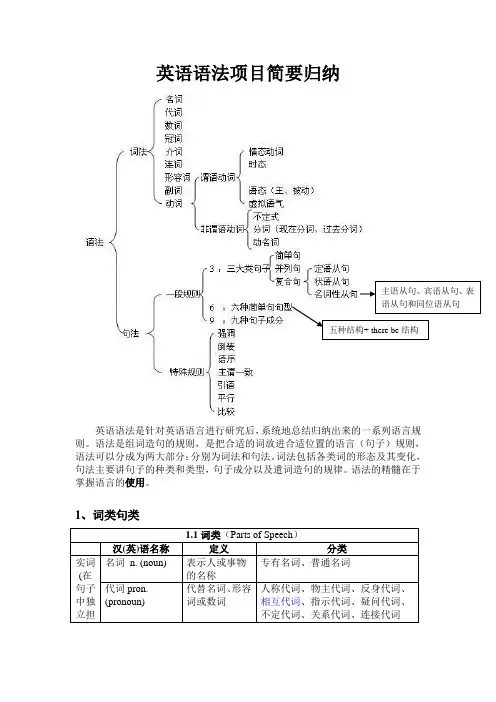
英语语法项目简要归纳英语语法是针对英语语言进行研究后,系统地总结归纳出来的一系列语言规则。
语法是组词造句的规则,是把合适的词放进合适位置的语言(句子)规则,语法可以分成为两大部分:分别为词法和句法。
词法包括各类词的形态及其变化,句法主要讲句子的种类和类型,句子成分以及遣词造句的规律。
语法的精髓在于掌握语言的使用。
1、词类句类2、词语介绍2.1、名词介绍名词(noun)是指人或事物的名称。
名词一般分为专有名词(proper noun)和普通名词(common noun)。
专有名词是个别的人、事物、地点、团体、机构等专有的名称,首字母通常大写。
名词按其所表示的事物的性质也可以分为可数名词(countable noun)和不可数名词(uncountable noun),可数名词有单数和复数形式。
2.2、代词介绍代词(pronoun)用于代替名词等。
代词分为人称代词、物主代词、指示代词、反身代词、相互代词、疑问代词、关系代词、连接代词和不定代词。
2.2.1.人称代词代替人或事物的名称,分为主格人称代词和宾格人称代词两种。
词两种。
形容词性物主代词相当于形容词,置于名词前做定语。
名词性物主代词2.3、数词介绍数词表示数量或顺序等。
分为基数词(cardinal number)和序数词(ordinal number)。
2.4、动词介绍但要与动词原形以及其被动语态一起使用,谓语动词增添情态色彩,表示说话人对有关行为或事物的态度和看法,认为其可能、应该或必要等。
情态动词后面加动词原形。
1.情态动词不能表示正在发生或已经发生的事情,只表示期待或估计某事的发生。
2.情态动词除ought 和have外,后面只能接不带to的不定式。
3.情态动词不随人称的变化而变化,即情态动词的第三人称单数不加-s。
情态动词不受任何时态影响即不加三单。
4.情态动词没有非谓语形式,即没有不定式、分词等形式。
2.5、感叹词感叹词是用来表示说话时表达的喜、怒、哀、乐等情感的词。
常用英语短语500组(三)
1. rob A of B把B从A抢走e.g.: Three men robbed her of all her money. 三个人抢走了她所有的钱。
2. Why don’t you…?你为什么不…?e.g.: Why don’t you try the new app? 你为什么不试试这个新的应用程序?3. attend to听取;照顾e.g.: We should attend to their needs. 我们应该照顾他们的需要。
4. bring A home to B让A意识到Be.g.: Talks with him bring home to me his self-confidence. 和他谈话使我感受到他的自信。
5. make sense合理;有意义e.g.: Your answer doesn’t make sense. 你的回答没有道理。
6. turn…off关掉e.g.: Turn the light off when you leave the room. 离开房间时把灯关掉。
7. look into研究;寻找e.g.: We should look into that possibility. 我们应该探究这种可能性。
8. carry…out实施e.g.: After reviewing the plan, Bill will carry it out. 在检验计划之后,比尔将进行实施。
9. out loud响亮地e.g.: He laughed out loud. 他大声笑了出来。
10. be aware of意识到e.g.: The girl is not aware of my standing behind her. 那女孩不知道我站在她身后。
11. in addition to除…之外e.g.: In addition to good health, he has a good brain. 除了身体好外,他还很有头脑。
英短短语
Just about 差不多、几乎:Just about everything he said was ture.他说的几乎句句都是实话。
At home and abroad 国内外:Mean-while the political situation at home and abroad has changed.当时国内外的政治局势已经发生了变化。
Go abrosd 出国:She often goes abroad on business.她常因公去国外。
Absence of mind 心不在焉:He made many mistakes due to absence of mind.他因思想不集中,犯了许多错误。
Absent from 不在,缺席:I will be absent from work tomorrow.明天我不去上班。
Absolute 绝对的,完全的:please tell the absolute truth。
请说出全部事情真相。
Absorb vt、吸收,吸引:anything black absorbs most of the light rays that fall on it。
任何黑色的东西都能吸收照射到它上面的大部分光线。
Abstract adj、抽象的:A flower is beautiful,but beauty itself is abstract。
花是美丽的,可美丽本身则是抽象的。
n、提要,摘要:please make an abstract of your paper。
请写出你的论文摘要。
v、提取:they can abstract iron from ore。
他们能够从矿石中提取铁。
Be abundant in 富产,富有,多产:The river is abundant in salmon。
这条河盛产鲑鱼。
小学六年级常个英见的50语短句翻译
小学六年级常个英见的50语短句翻译1. I'm very happy. (我非常开心。
)2. How are you? (你好吗?)3. Nice to meet you. (很高兴见到你。
)4. What's your name? (你叫什么名字?)5. My name is Lily. (我的名字是莉莉。
)6. How old are you? (你几岁了?)7. I'm twelve years old. (我十二岁了。
)8. This is my friend. (这是我的朋友。
)9. Where are you from? (你来自哪里?)10. I'm from China. (我来自中国。
)11. What's this? (这是什么?)12. It's a pen. (它是一支钢笔。
)13. How many books do you have? (你有多少本书?)14. I have five books. (我有五本书。
)15. What color is it? (它是什么颜色?)16. It's red. (它是红色的。
)17. Do you like apples? (你喜欢苹果吗?)18. Yes, I do. (是的,我喜欢。
)19. No, I don't. (不,我不喜欢。
)20. Can you swim? (你会游泳吗?)21. Yes, I can. (是的,我会。
)22. No, I can't. (不,我不会。
)23. What time is it? (几点了?)24. It's six o'clock. (六点了。
)25. It's time for breakfast. (该吃早餐了。
)26. Have a nice day! (祝你有美好的一天!)27. Thank you. (谢谢。
全英教学授课用语
72.Will you lease correct his mistake?请你纠正他的错误好吗?
73.We are going to have a revision lesson today.今天我们上复习课。
74.What’s the noun form of this word?这个词的名词形式是什么?
4.围成一个圈.Make a circle.
5.3人一组.Play in group of three.
6.排成2队.Make two lines.
7.加油.Come on.
8.从你开始You go first.
9.轮到谁了?Whose turn?
10.下一个是谁?Who’s next?
11.等一下.Wait/Just a second.
86. Hand in your exercise books.把本子交上来。
87. Put down your pens.把笔放下。
(五)游戏用语
1.我们来唱首歌吧Let’s sing a song.
2.你们还记得那首歌么?Do you remember the song?
3.仔细听游戏规则.Listen to the instructions carefully.
15. Go back to your seat.回到你的座位去
16. Now , let’s begin.现在开始吧。
17. Listen carefully.注意听。
(四)教学指示语In class(在课堂上)
1. I can’t hear you.对不起,我听不见
2. Pardon?对不起,你说什么
- 1、下载文档前请自行甄别文档内容的完整性,平台不提供额外的编辑、内容补充、找答案等附加服务。
- 2、"仅部分预览"的文档,不可在线预览部分如存在完整性等问题,可反馈申请退款(可完整预览的文档不适用该条件!)。
- 3、如文档侵犯您的权益,请联系客服反馈,我们会尽快为您处理(人工客服工作时间:9:00-18:30)。
英语短语大全及常用词组
一、动词+介词
1.look at…看…,look like … 看上去像……,look after …照料…
2.listen to…听……
3.welcome to…欢迎到……
4.say hello to …向……问好
5.speak to…对……说话
此类短语相当于及物动词,其后必须带宾语,但宾语无论是名词还是代词,都要放在介词之后。
二、动词+副词
1.put on 穿上2.take off脱下3.write down记下
B.动词(vi)+副词。
1.come on赶快2.get up起床3.go home回家
4.come in进来5.sit down坐下6.stand up起立
三、其它类动词词组
1.close the door
2.1ook the same
3.go to work/class
4.be il l
5.have a look/seat
6.have supper
7.1ook young 8.go shopping 9.watch TV/games
10. play games
1.in+语言/颜色/衣帽等,表示使用某种语言或穿着……。
2.in + Row/ Team/ Class/ Grade等,表示“在……排/队/班级/年级”等。
3.in the morning/ afternoon/ evening/ 表示“在上午/下午/傍晚”等一段时间。
4.in the desk/ pencil-box/bedroom 等表示“在书桌/铅笔盒/卧室里”。
5.in the tree表示“在树上(非树本身所有)”;on the tree表示“在树上(为树本身所有)”。
6.in the wall表示“在墙上(凹陷进去)”;on the wall表示“在墙上(指墙的表面)”。
7.at work(在工作)/at school(上学)/at home(在家)应注意此类短语中无the。
8.at + 时刻表示钟点。
9.like this/that表示方式,意为“像……这/那样”。
10.of短语表示所属关系。
11.behind/ beside/ near/ under+ 名词等,表示方位、处所。
12.from与to多表示方向,前者意为“从……”,后者意为“到……”。
另外,以下这些短语也必须掌握。
如:on duty, after breakfast, at night, at the door, in the middle, in the sky, on one’s bike等。
重点句型大回放]
1.I think…意为“我认为……”,是对某人或某事的看法或态度的一种句型。
其否定式常用I don’t think…,
2.give sth. to sb./ give sb. sth. 意为“把……给……”,b.
3.take sb./ sth. to…意为“把……(送)带到……”,后常接地点,也可接人。
4.One…, the other…/One is…and one is…意为“一个是……;另一个是……”,
必须是两者中。
5.Let sb. do sth. 意为“让某人做某事”,
6.help sb. (to) do sth./help sb. with sth.意为“帮助某人做某事”。
.
7.What about…?/How about…?意为“……怎么样?”是用来询问或征求对方的观点、意见、看法等。
9.like to do sth./like doing sth.意为“喜欢做某事”,前一种句型侧重具体的一次性的动作;后一种句型侧重习惯性的动作,
10.ask sb.(not) to do sth. 意为“让某人(不要)做某事”。
11.show sb. sth. / show sth. to do. 意为“把某物给某人看”,该句型的用法同前面第2点。
12.introduce sb. to sb. 意为“把某人介绍给另一人”;introduce to sb.则是“向某人作介绍”。
[重点短语快速复习]
1.kinds of 各种各样的
2. either…or…或者……或者……,不是……就是……
3. neither…nor…既不……也不……
4. Chinese tea without, anything in it 中国清茶
5. take a seat 就坐
6. home cooking 家常做法
7. be famous for 因……而著名
8. on ones way to在……途中
9. be sick/ill in hospital生病住院
10. at the end of在……的尽头,在……的末尾
11. wait for 等待
12. in time 及时
13. make one’s way to…往……(艰难地)走去
14. just then 正在那时
15. first of all 首先,第一
16. go wrong 走错路
17. be/get lost 迷路
18. make a noise 吵闹,喧哗
19. get on 上车
20. get off 下车
21. stand in line 站队
22. waiting room 候诊室,候车室
23. at the head of……在……的前头
24. laugh at 嘲笑
25. throw about 乱丢,抛散
26. in fact 实际上
27. at midnight 在半夜
28. have a good time=enjoy oneself玩得愉快
29. quarrel with sb. 和某人吵架
30. take one’s temperature 给某人体温
31. have/get a pain in…某处疼痛
32. have a headache 头痛
33. as soon as… 一……就……
34. feel like doing sth. 想要干某事
35. stop…from doing sth. 阻止……干某事
36. fall asleep 入睡
37. again and again再三地,反复地
38. wake up 醒来,叫醒
39. instead of 代替
40. look over 检查
41. take exercise运动
42. had better(not) do sth. 最好(不要)干某事
43. at the weekend 在周末
44. on time 按时
45. out of从……向外
46. all by oneself 独立,单独
47. lots of=a lot of 许多
48. no lo nger/more=not…any longer/more 不再
49. get back 回来,取回
50. sooner or later迟早
51. run away 逃跑
52. eat up 吃光,吃完
53. run after 追赶
54. take sth. with sb. 某人随身带着某物
55. take(good) care of…=look after…(well) (好好)照顾,照料
56. think of 考虑到,想起
57. keep a diary 坚持写日记
58. leave one by oneself 把某人单独留下
59. harder and harder 越来越厉害
60. turn on打开(电灯、收音机、煤气等)
61. turn off 关。
